14 - 5 - 0 ---4th Ranked
209.37 Yds/Game ---10th Ranked
185.74 Yds/Game ---8th Ranked
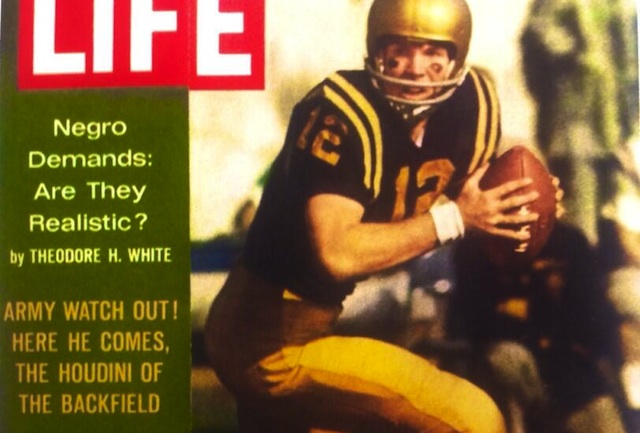
Before the TLL, my encounter with the
name Roger Staubach was a very brief one.
It must have been the early 2000s, when the real estate market was on
the rise, that I walked into The Staubach Company’s New York offices. My brother, who now has his MA in Urban
Planning and Development, had been offered a second job working on a project
for Staubach’s company. After he worked
for about a week there, he thought that the work might be more suitable for me,
a young college student who did not have much experience in the modern office. My days had mostly been spent tucked away in
the library at college studying sociology or philosophy. The name Roger Staubach was a remote one; it elicits the same foggy feeling I get as when any baby boomer talks about "the sixties." The year he retired was the year I was born.
I must have been off for the summer around 19 or 20 years old when I walked in that office. The vague recollection I have of that day was that I was to sit down at a desk and update parts of their GIS (Geographic Information Systems) for select areas in New Jersey. The Staubach Company was a real estate company, so I was certain that the work I would be doing must have had something to do with real estate matters, but my young brain could not fathom what importance, if any, that the project would have. Real estate? Office life? New Jersey? What relevance did it have to me? Nevertheless, I remember that one of the workers at the Staubach Company asked me how long I could be working there on this project. I mentioned to her that the thought of working with maps interested me greatly, but in about a month, my dad had to take me back to college. They must have looked at me when I walked in and saw how young I was--and I was even much younger looking then-- but they still asked the question anyway.
I think the answer was clear that I would not be working there.


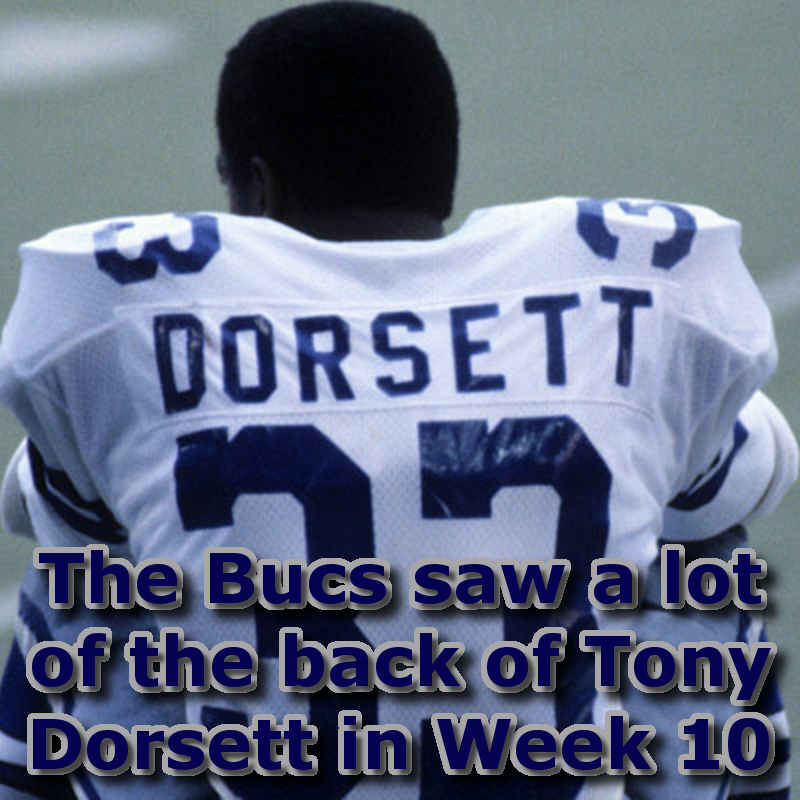
Has Marshawn Lynch surpassed Tony Dorsett as the Seattle Seahawks' all-time greatest running back? It would be an interesting debate, except, of course, for the fact that Dorsett never played a down for Seattle. But he could have.
We all know how rough a year 1976 was for the Seahawks and the Tampa Bay Buccaneers. They were the first two expansion teams to enter the post-merger NFL, but they had none of the benefits of an expansion draft that the Panthers and Jaguars would have nearly 20 years later. They were left to construct teams out of the scraps that other teams didn't want. (One of those, incidentally, was Steve Largent, who had spent training camp with Houston in 1976. Bum Phillips said he was too small and too slow to make it in the "man's" NFL.)
Unsurprisingly, Tampa and Seattle struggled mightily in their first year and were granted the first and second overall picks, respectively. The Bucs, under former USC coach John McKay, made it clear that they would be drafting Trojan running back RIcky Bell, who'd won a national championship with McKay at the helm. This left Seattle to draft Tony Dorsett, who had set the world on fire during his time at the University of Pittsburgh, having rushed for 2,150 yards on his way to the Heisman in his senior year. Swish that number around a bit. 2,150.
One thing that both Steve and I found puzzling in the early years of the TLL is how Dallas, a team that had won the NFC East in 1976, could have wound up with the #2 overall pick to draft Dorsett. It seemed like a clear case of the rich getting richer. Well, Steve and everyone else, here's how it happened.
Dorsett's agent phoned the Seahawks front office well ahead of the draft with the message that Dorsett had no intention of playing in Seattle. So, the Seahawks shopped the pick, and the pick-richest of all the teams in the NFL was Dallas in 1976.
The deal itself, and all the subsequent deals, is somewhat mind-boggling, and I'm still not sure after reading about it for a while that I quite understand all its intricacies. But I know it all starts with Clint Longley.
Longley had been drafted as a supplemental pick by Cincinnati in 1974, and then sent to Dallas for a 5th-round 1975 pick. He didn't play much, but became Roger Staubach's backup after Craig Morton, who complained vocally about Staubach's being named the full-time starter that season, was traded to the Giants. Then, on Thanksgiving Day in 1974, with the Cowboys trailing Washington 16-3 in the 3rd quarter, Staubach was knocked out of the game. The Washington coaching staff had offered the defense a $200 bounty to injure the Cowboys' QB, with Diron Talbert noting that Washington's main goal for the game was to get "that rookie" into the game.
What happened from there is the stuff of legend. Longley ended up bringing Dallas all the way back, capping the comeback with a 50-yard touchdown pass to Preston Pearson with less than a minute to go. It earned him the nickname "The Mad Bomber" (which isn't all that creative considering that Daryle Lamonica was already called that) and the adoration of Dallas fans.
But by 1976, things had changed. The Cowboys had drafted Danny White to be the quarterback of the future, and Longley was clearly number 3 in the pecking order. In training camp during a passing drill on August 8th, Longley was berating Drew Pearson when Staubach came to his favorite target's aid: "Somebody is gonna knock those Bugs Bunny teeth of yours in." This pushed Longley over the edge, and he began swinging, which turned out to be a bad idea after Staubach, the former Navy man, put him in his place. According to Pearson, Staubach "put all that combat training to use. . . . Roger slammed him to the ground. All of a sudden, Clint's feet were headed north and his head was facing south."
Still seething two days later, Longley walked into the locker room where Staubach was standing at his locker. Longley walked up behind the star and sucker-punched him right in the head. Staubach went straight to the floor and was rushed to the hospital where he received nine stitches for his wounds.
Fortunately, Roger the Dodger didn't miss any regular-season playing time. But if Longley was trying to endear himself to the Cowboys, cheap-shotting the face of the organization was probably not the way to do it. On August 30th, he was traded to San Diego for what were at the time described "undisclosed draft picks." We felt that it was in the best interest of the team as well as Clint that we trade him," Tom Landry said.
Bear in mind that by this point in his career, Clint Longley had amassed a grand total of 44 passing attempts, of which he completed 19. Not only that, but he was also coming off a very public incident in which he cowardly attacked perhaps the most beloved player in the NFL. So what do you think those "undisclosed picks" were? A 6th-rounder, maybe?
Nope.
In return for Longley and the Cowboys' first-round pick in 1977 (which turned out to be #24), the Chargers gave up their first- and second-round picks in the 1977 draft, which were 14th in both rounds. To me, that's mind-boggling. How the Dallas Cowboys managed not only to dump a third-string locker-room cancer, but also to move up in the first round and gain an additional 2nd-round pick is baffling to me.
Herschel Walker trade be damned: the Clint Longley trade has to be the greatest piece of business that the Dallas Cowboys ever did.
The Cowboys had additional 2nd-round picks from other trades, and in early 1977 they sent the Seahawks those first- and second-rounders and two other 2nd-round picks. And they got more than just the #2 overall pick; Seattle also sent a 3rd-round pick that they'd gotten from Atlanta and that Dallas would use to draft Tony Hill, the franchise's leading receiver over the next decade, and still third all time in franchise receiving yards with just under 8,000.
It's not that the Seahawks did particularly poorly in the trade. With the four picks, they were able to select three multi-year starters: offensive linemen Steve August and John Lynch, and linebacker Terry Beeson.
But we're not here to talk about mid-level starters or even stars as bright as Tony Hill. The Cowboys selected Tony Dorsett with the 2nd pick of the 1977 draft, and for the next decade, he ran rampant. He was the ultimate home-run hitter, with Washington coach Joe Gibbs once remarking. "You'll hold him on ten plays for just a yard or two, and you feel like you have him stopped. Then he'll hit you for fifty yards three times in a quarter." Those 50-yard gains piled up, with Dorsett hitting 1,000 yards in 8 of his first 9 years in the league, only missing out in the strike-shortened 1982 season, when he was on pace for another 1,500.
Dorsett is on pace for yet another 1,000-yard season in the TLL, and it's performances like the one he displayed in Week 10 that cement his position as one of the league's true game-changers. In a game with large potential playoff implications, the Cowboys went down big early and trailed the Bucs 18-0 in the first half. But Dorsett took the team on his back, and a stellar 2nd-half performance including a number of electrifying runs, including two for touchdowns, the Cowboys came back to beat Tampa Bay 27-21 in overtime. His 12 carries yielded 111 yards in the win.


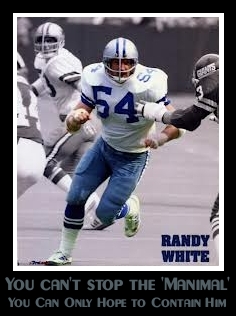
With PERHAPS the exception of Harvey Martin, Randy White is the most famed member of the second generation Doomsday Defense, a moniker given to the mid 70’s-early 80’s defenses of the Dallas Cowboys. White was drafted by the Cowboys as a linebacker in the 1975 draft, largely on the merit of his speed and high motor. Soon, though, White found himself anchoring the Cowboy defensive line, primarily as an inside tackle. His speed made him a nightmare for offensive linemen. Beginning in 1977, and running through 1985, White earned pro bowl honors, and his performance throughout the 1978 season led to being named Defensive Player of the year.
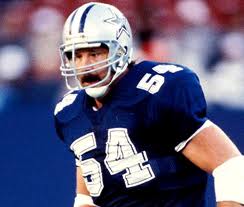
Thus far, in the Tecmo Legacy League (TLL) 78 season White is on the same trajectory, as through six games he heads the league in sacks with 10, while adding a ridiculous 29 tackles, good for sixth amongst all defenders.
In Week 4, the ‘Manimal’ aka the 'Manster' (half man/half monster) earned defensive player of the week, as individually he made 9 tackles, while in the meantime sacking Joe Pisarcik 4 times. As a unit the Dallas defense gave up three total yards. Ha-What? We do not currently have the official records but that has to be the TLL all-time record.
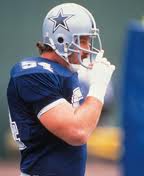
Throughout his 14 season, hall of fame career White missed just one game. It is safe to say that the TLL Cowboys will have the ‘Manimal Manster’ prowling offensive backfields for years yet to come.
Passing Leaders
| NAME | COMP | YRDS | |
|---|---|---|---|
 | Danny White | 132 | 2609 |
View Complete Stats
Rushing Leaders
| NAME | ATT | YRDS | |
|---|---|---|---|
 | Tony Dorsett | 89 | 752 |
| Ron Springs | 69 | 446 | |
| Robert Newhouse | 11 | 99 | |
| Timmy Newsome | 13 | 58 | |
| Butch Johnson | 1 | 7 |
View Complete Stats
Recieving Leaders
| NAME | REC | YRDS | |
|---|---|---|---|
 | Tony Hill | 31 | 1096 |
| Drew Pearson | 32 | 678 | |
| Ron Springs | 27 | 309 | |
| Tony Dorsett | 19 | 229 | |
| Doug Cosbie | 12 | 170 |
View Complete Stats
Tackle Leaders
Interception Leaders
Sack Leaders
| OFFENSE | DEFENSE | SPECIAL TEAMS |
|---|---|---|
| Passing | Tackles | XP/FG |
| Rushing | Sacks | Punting |
| Recieving | Interceptions | Kick Returns |
| Scrimmage Yards | Forced Fumbles | Punt Returns |
| Scoring | Touchdowns | Scoring |
| Name | # | Age | RS | RP | MS | HP | BB | AG | PS | PC | PA | AR | CO |
|---|---|---|---|---|---|---|---|---|---|---|---|---|---|
| Danny White | 11 | 30 | 69 | 25 | 19 | 13 | 38 | 38 | 50 | 69 | 56 | 44 | 63 |
| Gary Hogeboom | 14 | 24 | 69 | 25 | 6 | 13 | 19 | 25 | 50 | 44 | 31 | 38 | 38 |
| Name | # | Age | RS | RP | MS | HP | BB | AG | BC | RE |
|---|---|---|---|---|---|---|---|---|---|---|
| Tony Dorsett | 33 | 28 | 69 | 50 | 63 | 25 | 69 | 69 | 63 | 38 |
| Ron Springs | 20 | 26 | 69 | 44 | 44 | 44 | 38 | 63 | 69 | 31 |
| Timmy Newsome | 30 | 24 | 69 | 38 | 38 | 44 | 31 | 56 | 56 | 25 |
| Robert Newhouse | 44 | 32 | 69 | 38 | 31 | 44 | 19 | 19 | 69 | 19 |
| Name | # | Age | RS | RP | MS | HP | BB | AG | BC | RE |
|---|---|---|---|---|---|---|---|---|---|---|
| Tony Hill | 80 | 26 | 69 | 50 | 50 | 13 | 50 | 63 | 75 | 63 |
| Drew Pearson | 88 | 31 | 69 | 44 | 44 | 13 | 44 | 63 | 63 | 56 |
| Butch Johnson | 86 | 28 | 69 | 31 | 56 | 13 | 38 | 50 | 69 | 44 |
| Doug Donley | 83 | 23 | 69 | 31 | 31 | 13 | 19 | 44 | 44 | 25 |
| Name | # | Age | RS | RP | MS | HP | BB | AG | BC | RE |
|---|---|---|---|---|---|---|---|---|---|---|
| Doug Cosbie | 84 | 26 | 69 | 44 | 38 | 38 | 50 | 38 | 63 | 50 |
| BJ DuPree | 89 | 31 | 69 | 19 | 19 | 44 | 13 | 25 | 63 | 25 |
| Name | # | Age | RS | RP | MS | HP | BB | AG |
|---|---|---|---|---|---|---|---|---|
| Tom Rafferty | 64 | 28 | 69 | 25 | 19 | 63 | 13 | 13 |
| Kurt Petersen | 65 | 25 | 69 | 38 | 31 | 50 | 38 | 38 |
| Howard Richards | 70 | 23 | 69 | 19 | 31 | 56 | 13 | 38 |
| Jim Cooper | 61 | 27 | 69 | 25 | 25 | 69 | 13 | 25 |
| Pat Donovan | 67 | 29 | 69 | 56 | 38 | 75 | 44 | 56 |
| Name | # | Age | RS | RP | MS | HP | BB | AG | INT | QU |
|---|---|---|---|---|---|---|---|---|---|---|
| Tootall Jones | 72 | 31 | 56 | 44 | 56 | 69 | 13 | 44 | 19 | 81 |
| John Dutton | 78 | 31 | 31 | 50 | 38 | 56 | 13 | 19 | 6 | 50 |
| Randy White | 54 | 29 | 50 | 44 | 56 | 75 | 13 | 38 | 6 | 81 |
| Harvey Martin | 79 | 32 | 50 | 44 | 56 | 56 | 13 | 19 | 6 | 63 |
| Larry Bethea | 76 | 26 | 31 | 19 | 25 | 38 | 13 | 19 | 6 | 25 |
| Don Smerek | 60 | 25 | 38 | 31 | 19 | 31 | 13 | 13 | 6 | 25 |
| Name | # | Age | RS | RP | MS | HP | BB | AG | INT | QU |
|---|---|---|---|---|---|---|---|---|---|---|
| Mike Hegman | 58 | 29 | 44 | 25 | 44 | 56 | 19 | 38 | 13 | 50 |
| Bob Breunig | 53 | 29 | 50 | 56 | 56 | 56 | 19 | 38 | 25 | 81 |
| Guy Brown | 59 | 27 | 44 | 31 | 38 | 38 | 19 | 44 | 19 | 38 |
| Anthony Dickerson | 51 | 26 | 38 | 38 | 25 | 38 | 19 | 44 | 19 | 31 |
| Angelo King | 57 | 24 | 31 | 25 | 31 | 38 | 19 | 31 | 13 | 25 |
| Name | # | Age | RS | RP | MS | HP | BB | AG | INT | QU |
|---|---|---|---|---|---|---|---|---|---|---|
| Everson Walls | 24 | 23 | 56 | 44 | 56 | 25 | 44 | 75 | 75 | 81 |
| Dennis Thurman | 32 | 26 | 44 | 31 | 44 | 13 | 44 | 75 | 56 | 56 |
| Rod Hill | 25 | 23 | 31 | 38 | 44 | 13 | 50 | 50 | 38 | 38 |
| Monty Hunter | 34 | 23 | 50 | 25 | 38 | 13 | 44 | 44 | 25 | 31 |
| Benny Barnes | 31 | 31 | 44 | 44 | 56 | 25 | 44 | 31 | 31 | 44 |
| Michael Downs | 26 | 23 | 31 | 50 | 50 | 56 | 44 | 56 | 44 | 56 |
| Dextor Clinkscale | 47 | 24 | 31 | 25 | 38 | 38 | 25 | 44 | 38 | 38 |
| Name | # | Age | RS | RP | MS | HP | BB | AG | KP | AB | AC |
|---|---|---|---|---|---|---|---|---|---|---|---|
| Rafael Septien | 1 | 29 | 81 | 56 | 81 | 31 | 13 | 38 | 63 | 50 | 50 |
| Name | # | Age | RS | RP | MS | HP | BB | AG | KP | AB |
|---|---|---|---|---|---|---|---|---|---|---|
| Danny White | 11 | 30 | 81 | 25 | 44 | 31 | 13 | 38 | 56 | 63 |
Additional Practice Squad Players
--------------------No Players---------------------
14 - 5 - 0
4th
8 - 4 - 0
24th
6 - 1 - 0
27th
137.32 Yds/Game
8th
72.05 Yds/Game
19th
209.37 Yds/Game
7th
121.21 Yds/Game
8th
64.53 Yds/Game
6th
185.74 Yds/Game
6th
| Name | Year |
|---|
| Name | Year |
|---|
| Name | Year |
|---|
| Name | Year |
|---|
| Name | Year |
|---|
| Name | How Many |
|---|






0 COMMENTS